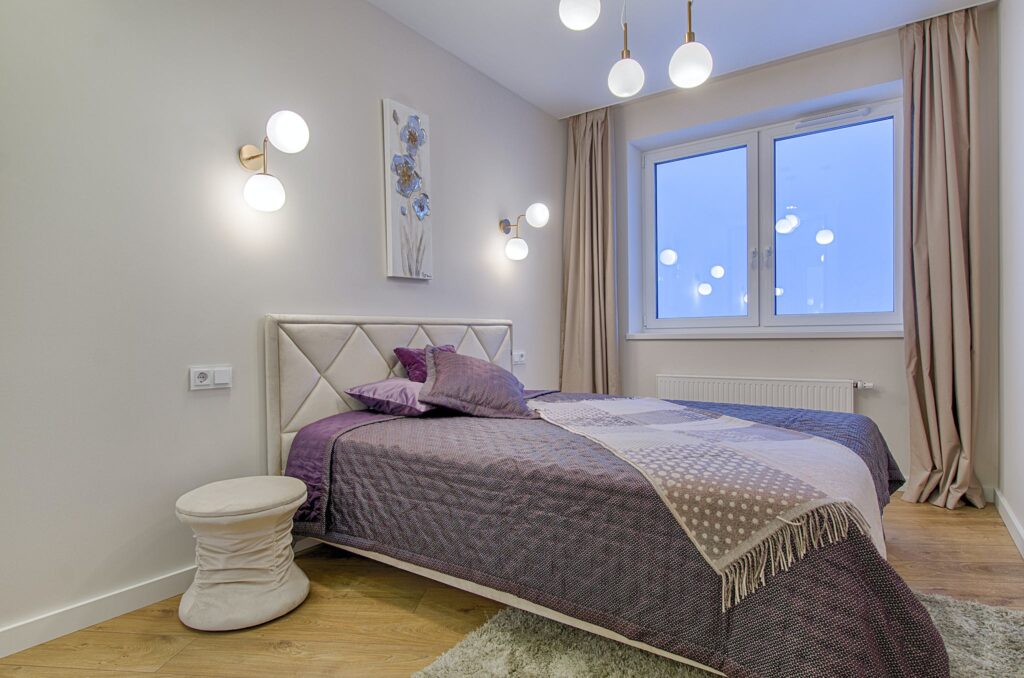How to Design Your Bedroom for Optimal Sleep

Understanding the Importance of Bedroom Design for Quality Sleep

A good night’s sleep is essential for overall health and well-being. Many factors can affect the quality of our sleep, and one often overlooked element is the design of our bedroom. The way we arrange and decorate our sleeping environment can greatly impact our ability to relax and achieve restful sleep. Understanding the importance of bedroom design for quality sleep is crucial in optimizing our sleep environment.
Firstly, we must consider the layout and furniture placement in our bedroom. A cluttered and disorganized space can create a sense of chaos and hinder relaxation. By implementing an effective room layout and thoughtful furniture placement, we can create a serene and inviting atmosphere that promotes relaxation. Additionally, decluttering our bedroom space not only creates a sense of calm but also reduces potential allergens that can disrupt our sleep. Taking the time to organize our bedroom can have a significant impact on the quality of our sleep.
Next, we need to focus on controlling and managing the lighting in our bedroom. Bright, harsh lights can interfere with our body’s natural circadian rhythms and make it difficult to fall asleep. By incorporating adjustable lighting options, such as dimmer switches or bedside lamps with soft, warm hues, we can create a soothing ambiance that signals to our body that it’s time for rest. It’s also important to minimize the presence of electronic devices that emit blue light, as this type of light can disrupt our sleep patterns. By implementing these lighting strategies, we can optimize the sleep environment and promote quality rest.
Creating a Calming Color Scheme for Your Bedroom

Creating a calming color scheme for your bedroom is an essential element in setting the right atmosphere for quality sleep. Colors have a significant impact on our mood and emotions, and choosing the right ones can help create a serene and peaceful environment that promotes relaxation.
When it comes to selecting colors for your bedroom, it is important to opt for shades that evoke a sense of tranquility and promote a restful state. Soft, muted tones such as blues, greens, and neutrals are popular choices for creating a calming color scheme. These colors have been scientifically proven to have a soothing effect on the mind and body, helping to reduce stress and anxiety levels.
It is crucial to avoid vibrant and bold colors, as they can stimulate the senses and make it challenging to relax. Instead, opt for softer hues and shades that create a sense of calm and serenity. Picking colors that are reminiscent of nature, such as gentle blues like sky or sea, earthy greens, or soothing neutrals like soft beiges or grays, can have a calming effect on both the body and mind.
Creating a calming color scheme for your bedroom is just one step in creating an optimal sleep environment. By choosing the right colors, you can create a serene and peaceful space that promotes relaxation and enhances the quality of your sleep.
Choosing the Right Mattress for Maximum Comfort

A good night’s sleep is crucial for optimal health and well-being, and the right mattress plays a significant role in ensuring maximum comfort. When it comes to choosing the right mattress, there are several factors to consider. Firstly, it’s essential to understand that everyone has unique preferences and requirements when it comes to sleep comfort. Therefore, it’s essential to find a mattress that suits your individual needs.
One of the primary considerations is the firmness of the mattress. The level of firmness required varies from person to person, depending on their body weight, sleeping position, and personal preferences. A mattress that is too firm can cause discomfort and result in pressure points, while a mattress that is too soft may not provide adequate support for your body. It is recommended to try out different levels of firmness and determine which one provides the optimal balance of comfort and support for you. Additionally, considering factors such as mattress material, durability, and hypoallergenic properties can further enhance your overall sleep experience.
Selecting Suitable Bedding and Pillows for a Restful Sleep

When it comes to getting a restful sleep, selecting suitable bedding and pillows plays a crucial role. The right bedding can provide the necessary comfort and support for your body, allowing you to relax and drift off to sleep more easily. Additionally, pillows that suit your sleeping position can help maintain proper spinal alignment, reducing the risk of waking up with aches and pains.
When choosing bedding, opt for breathable materials such as cotton or linen that can help regulate body temperature throughout the night. These fabrics allow air to circulate, preventing you from overheating or feeling too cold. Additionally, consider investing in high-quality bedding that is soft and hypoallergenic to ensure a comfortable and hygienic sleep environment.
Equally important is selecting the right pillow. Different sleeping positions require different levels of support to maintain proper alignment of the head, neck, and spine. For instance, back sleepers may find medium-firm pillows to be the most suitable, while side sleepers may benefit from firm pillows that provide ample support to the neck and shoulders. Stomach sleepers, on the other hand, may prefer softer, flatter pillows to avoid strain on the neck.
Remember, the goal is to create a comfortable and conducive sleep environment that promotes relaxation and quality sleep. By carefully selecting suitable bedding and pillows, you can enhance your sleep experience and wake up feeling refreshed and rejuvenated.
Controlling and Managing Lighting in Your Bedroom

Lighting plays a crucial role in creating a relaxing and restful sleep environment in your bedroom. Properly controlling and managing the lighting can help to regulate your body’s internal clock, promote melatonin production, and enhance the quality of your sleep.
First and foremost, it is important to prioritize natural light during the day. Exposure to natural light has been linked to better sleep quality, mood improvement, and overall well-being. Ensure that your bedroom windows are unobstructed and let the sunlight in during the daytime. If privacy is a concern, consider using sheer curtains or blinds that can filter the light while maintaining your privacy. Additionally, positioning your bed near the window can maximize the benefits of natural light and provide a calming, outdoor view.
When it comes to artificial lighting, it is crucial to opt for warm and dimmable lights in your bedroom. Harsh and bright lighting can disrupt your sleep-wake cycle and make it difficult to relax before bedtime. Consider using soft and warm-toned bulbs, such as those in the range of 2,700 to 3,000 Kelvin, to create a cozy and inviting atmosphere. Dimmer switches or adjustable lamps are also beneficial, as they allow you to control the intensity of the light according to your needs and preferences.
Incorporating Natural Elements for a Tranquil Sleep Environment
Incorporating natural elements into your bedroom design can significantly contribute to creating a tranquil sleep environment. Natural elements such as plants, wood, and natural fabrics can help create a calming and soothing atmosphere that promotes relaxation.
Plants are not only aesthetically pleasing but also have several benefits for a better sleep. They can improve air quality by releasing oxygen and absorbing harmful pollutants. In addition, certain plants, such as lavender and jasmine, have been known for their calming properties, which can aid in reducing stress and promoting better sleep. Incorporating these plants into your bedroom can create a peaceful and serene atmosphere.
Wooden furniture and accents can also add a touch of nature to your sleep space. Wood has a natural and warm aesthetic that can create a sense of comfort and relaxation. Opting for furniture made from sustainable and eco-friendly materials further enhances the natural element of your bedroom design. Additionally, using natural fabrics, such as cotton or linen, for your bedding and curtains can further contribute to a tranquil sleep environment as they are breathable, hypoallergenic, and gentle on the skin.
Integrating natural elements into your bedroom design not only enhances the aesthetics of the space but also promotes a sense of calmness and tranquility, ultimately contributing to a more restful and rejuvenating sleep experience.
Minimizing Noise and Disturbances in Your Bedroom
Excessive noise and disturbances in the bedroom can significantly impact the quality of your sleep, leaving you feeling restless and groggy the next day. Creating a peaceful and tranquil sleep environment is essential for getting the restorative rest your body needs. Here are some practical tips for minimizing noise and disturbances in your bedroom.
First and foremost, consider investing in a high-quality set of earplugs or noise-canceling headphones. These can help reduce external noises such as traffic, construction, or noisy neighbors that may disrupt your sleep. Additionally, incorporating soundproofing elements into your bedroom, such as thick curtains or rugs, can help absorb and block out unwanted sounds.
Furthermore, it’s crucial to be mindful of the electronic devices present in your bedroom. The constant humming and beeping from cell phones, computers, or televisions can disturb your sleep cycle. Make an effort to keep these devices turned off or on silent mode during bedtime. If you need an alarm clock, consider using a non-electronic option like a traditional analog clock or a smart speaker with a sleep-friendly timer.
Remember, a quiet and serene sleep environment is essential for achieving restful sleep. By implementing these strategies, you can create a bedroom space where noise and disturbances are minimized, ultimately promoting better sleep quality.
Optimizing Temperature and Ventilation for Better Sleep
Maintaining optimal temperature and ventilation in your bedroom is crucial for achieving a restful sleep. The right balance of these factors can greatly impact the quality of your slumber, ensuring you wake up refreshed and rejuvenated each morning.
Temperature plays a significant role in promoting healthy sleep. Experts suggest that a cool room, typically between 60 and 67 degrees Fahrenheit (15-19 degrees Celsius), is most conducive to a good night’s rest. This temperature range helps to mimic the body’s natural decline in core temperature as you sleep, facilitating the onset of sleep and promoting deeper, uninterrupted sleep cycles. It is important to note that individual preferences can vary, so finding the temperature that works best for you is key. Experiment with different settings and take note of how you feel upon waking up each morning.
Ventilation is equally vital for creating an environment conducive to quality sleep. Proper airflow helps regulate temperature, removes stale air, and reduces allergens that could potentially disrupt your sleep. Opening a window, using a fan, or even investing in an air purifier can greatly enhance the ventilation in your bedroom. Additionally, ensuring your ventilation system is clean and free from blockages is essential in maintaining a healthy sleep environment. Regularly clean or replace air filters to prevent the accumulation of dust, pollen, and other irritants that can affect the quality of your sleep.
By optimizing temperature and ventilation in your bedroom, you can create an environment that supports restful sleep. Fine-tuning these factors to meet your individual preferences and needs can significantly contribute to your overall sleep health and well-being.
Organizing and Decluttering Your Bedroom Space for Relaxation
Organizing and decluttering your bedroom space is essential for creating a relaxing environment that promotes quality sleep. A cluttered space can lead to feelings of stress and anxiety, making it difficult to unwind and fall asleep. By taking the time to declutter your bedroom, you can create a peaceful oasis that promotes restorative sleep.
Start by assessing your bedroom and identifying areas that need to be decluttered. Remove any unnecessary items that are causing visual clutter, such as piles of clothes or excessive decorative objects. Consider implementing storage solutions to keep your belongings organized and out of sight, such as under-bed storage containers or closet organizers.
In addition to decluttering, it’s important to establish a system for maintaining organization in your bedroom. This may involve implementing a daily cleaning routine, organizing your belongings into designated storage areas, and regularly evaluating and purging items that are no longer needed. By maintaining an organized space, you can create a calming atmosphere that promotes relaxation and a restful night’s sleep.
Implementing Effective Room Layout and Furniture Placement
Creating an effective room layout and furniture placement is crucial for optimizing relaxation and promoting a restful sleep environment. When it comes to arranging your bedroom, it is important to consider both the functionality and aesthetics of the space.
Start by evaluating the size and shape of your room. Take note of any architectural features, such as windows or doors, as these can influence the placement of your furniture. Consider the flow of the room and aim to create a clear path from the entrance to the bed. This will not only make the space feel more open but also facilitate easy movement during nighttime visits to the bathroom. Additionally, be mindful of any potential hazards or obstacles that may disrupt your sleep, such as positioning sharp corners or furniture with noisy mechanisms near the bed. Ensuring a clutter-free layout will contribute to a calming atmosphere.
When selecting furniture, prioritize comfort and functionality. The bed should be the focal point of the room, so position it in a way that allows for easy access and provides a clear visual focus. Place bedside tables within arm’s reach of the bed, allowing for convenient storage of personal belongings and nighttime essentials. Consider incorporating furniture with storage capabilities, such as under-bed drawers or dressers, to help maintain a tidy and organized space. Additionally, ensure that there is sufficient space between furniture pieces, allowing for easy movement and preventing a cramped feel. By carefully considering the room layout and furniture placement, you can create a relaxing sanctuary that promotes restful sleep.
Enhancing Air Quality and Reducing Allergens in Your Bedroom
Maintaining good air quality in your bedroom is essential for a healthy and restful sleep environment. Allergens, such as dust mites, pet dander, and pollen, can often be the culprits behind sleep disruptions and discomfort. To reduce allergens in your bedroom, consider implementing a few simple strategies.
Firstly, regularly clean and vacuum your bedroom to minimize the accumulation of dust. Pay special attention to areas that tend to collect dust, such as carpets, curtains, and upholstered furniture. Use a vacuum cleaner with a high-efficiency particulate air (HEPA) filter to effectively trap even the smallest allergen particles. Additionally, consider using dust-mite-proof covers for your mattress, pillows, and bedding to create a barrier against these microscopic pests.
Next, it is important to keep the air in your bedroom fresh and well-ventilated. Open windows during the day to allow fresh air to circulate, and use a fan or air purifier to improve air circulation and filter out allergens. Regularly change and clean air filters in your heating and cooling systems to ensure they are not circulating dust and allergens throughout your bedroom. Lastly, avoid using harsh chemical products or sprays in your bedroom as they can emit volatile organic compounds (VOCs) that may worsen respiratory allergies. Instead, opt for natural cleaning solutions or those specifically designed for allergy sufferers.
Implementing Technology-Free Zones for Uninterrupted Sleep
In today’s modern world, technology plays a significant role in our daily lives. It has transformed the way we communicate, work, and entertain ourselves. However, the overuse of technology, especially in the bedroom, can have a negative impact on our sleep quality.
Implementing technology-free zones in our bedrooms can be a vital step towards uninterrupted sleep. The blue light emitted by electronic devices such as smartphones, tablets, and laptops can disrupt our circadian rhythm, making it harder to fall asleep and stay asleep throughout the night. By removing these distractions from our sleep environment, we create a space that promotes rest and relaxation.
Furthermore, having a technology-free zone in the bedroom reduces the temptation to engage in stimulating activities, such as browsing social media or watching videos, right before bed. These activities can stimulate the mind, making it harder to unwind and prepare for sleep. By creating a space free from digital distractions, we can encourage a more peaceful and calming bedtime routine, allowing our bodies and minds to prepare for a restful night’s sleep.
Creating a Nighttime Routine to Prepare Your Mind and Body for Sleep
To ensure a restful night’s sleep, establishing a nighttime routine that prepares your mind and body for rest is crucial. By following a consistent routine, you can signal to your body that it’s time to unwind and promote a more peaceful sleep environment. Here are some tips for creating an effective nighttime routine.
Firstly, it’s important to establish a consistent bedtime and wake-up time to regulate your body’s internal clock. Going to bed and waking up at the same time each day helps your body establish a regular sleep-wake cycle, making it easier to fall asleep and wake up feeling refreshed. Aim for a minimum of seven to eight hours of sleep each night to promote optimal health and cognitive functioning.
In addition to setting a consistent sleep schedule, incorporating relaxation techniques into your nighttime routine can help calm your mind and prepare you for sleep. Engaging in activities such as reading a book, taking a warm bath, or practicing meditation can help reduce stress and promote a sense of tranquility. Avoid stimulating activities or electronics close to bedtime as well, as the light emitted from screens can interfere with your body’s natural production of melatonin, a hormone that promotes sleep.
By establishing a regular sleep schedule and incorporating relaxation techniques into your nighttime routine, you can create an environment conducive to quality sleep. Incorporating these habits into your daily routine can have a profound impact on your overall sleep quality and ultimately, your well-being. So, take the time to prioritize your sleep and embrace the benefits of a well-structured nighttime routine.
Why is it important to have a nighttime routine?
Having a nighttime routine helps signal to your mind and body that it’s time to wind down and prepare for sleep. It can improve sleep quality and help you fall asleep faster.
What should I consider when designing my bedroom for better sleep?
When designing your bedroom for better sleep, consider factors such as color scheme, lighting, noise reduction, temperature control, and organization. These elements can contribute to creating a relaxing sleep environment.
How can I choose the right mattress for maximum comfort?
To choose the right mattress for maximum comfort, consider factors such as your preferred level of firmness, supportiveness, and your body type. It’s also essential to try out different mattresses and read reviews before making a decision.
What bedding and pillows should I choose for a restful sleep?
When selecting bedding and pillows for a restful sleep, consider materials that are comfortable, breathable, and hypoallergenic. Depending on your sleeping position and personal preferences, choose pillows that provide adequate support for your neck and spine.
How can I control and manage lighting in my bedroom?
To control and manage lighting in your bedroom, use blackout curtains or blinds to block out external light sources. Opt for dimmable bedside lamps or install smart lighting systems that allow you to adjust the brightness according to your needs.
What natural elements can I incorporate into my bedroom for a tranquil sleep environment?
Incorporating natural elements such as plants, natural fabrics, and soothing sounds like a small water fountain or nature-inspired music can create a tranquil sleep environment. These elements can help promote relaxation and reduce stress.
How can I minimize noise and disturbances in my bedroom?
To minimize noise and disturbances in your bedroom, consider using noise-cancelling curtains or white noise machines to block out external sounds. Ensure your bedroom is properly insulated and use earplugs if necessary.
How can I optimize temperature and ventilation for better sleep?
To optimize temperature and ventilation, keep your bedroom cool, well-ventilated, and at a comfortable temperature. Use fans, air purifiers, or adjust your thermostat accordingly to create an ideal sleep environment.
Why is organizing and decluttering my bedroom important for relaxation?
Organizing and decluttering your bedroom helps create a calm and clutter-free space, which can promote relaxation and reduce stress. A tidy bedroom can also contribute to a more restful sleep environment.
How can effective room layout and furniture placement enhance my sleep?
Effective room layout and furniture placement can enhance sleep by creating a sense of spaciousness and flow in your bedroom. Ensure that your bed is positioned in a way that allows for easy movement and access to natural light.
How can I enhance air quality and reduce allergens in my bedroom?
To enhance air quality and reduce allergens, regularly dust and vacuum your bedroom, keep windows open for fresh air circulation, and consider using air purifiers or plants that can naturally filter the air.
Why is it important to have technology-free zones for uninterrupted sleep?
Having technology-free zones in your bedroom helps create a screen-free environment that promotes relaxation and better sleep. The blue light emitted from electronic devices can interfere with your sleep quality.
How can I create a nighttime routine to prepare my mind and body for sleep?
To create a nighttime routine, establish a consistent sleep schedule, practice relaxation techniques like meditation or reading, avoid stimulating activities before bed, and create a peaceful environment that promotes relaxation.






